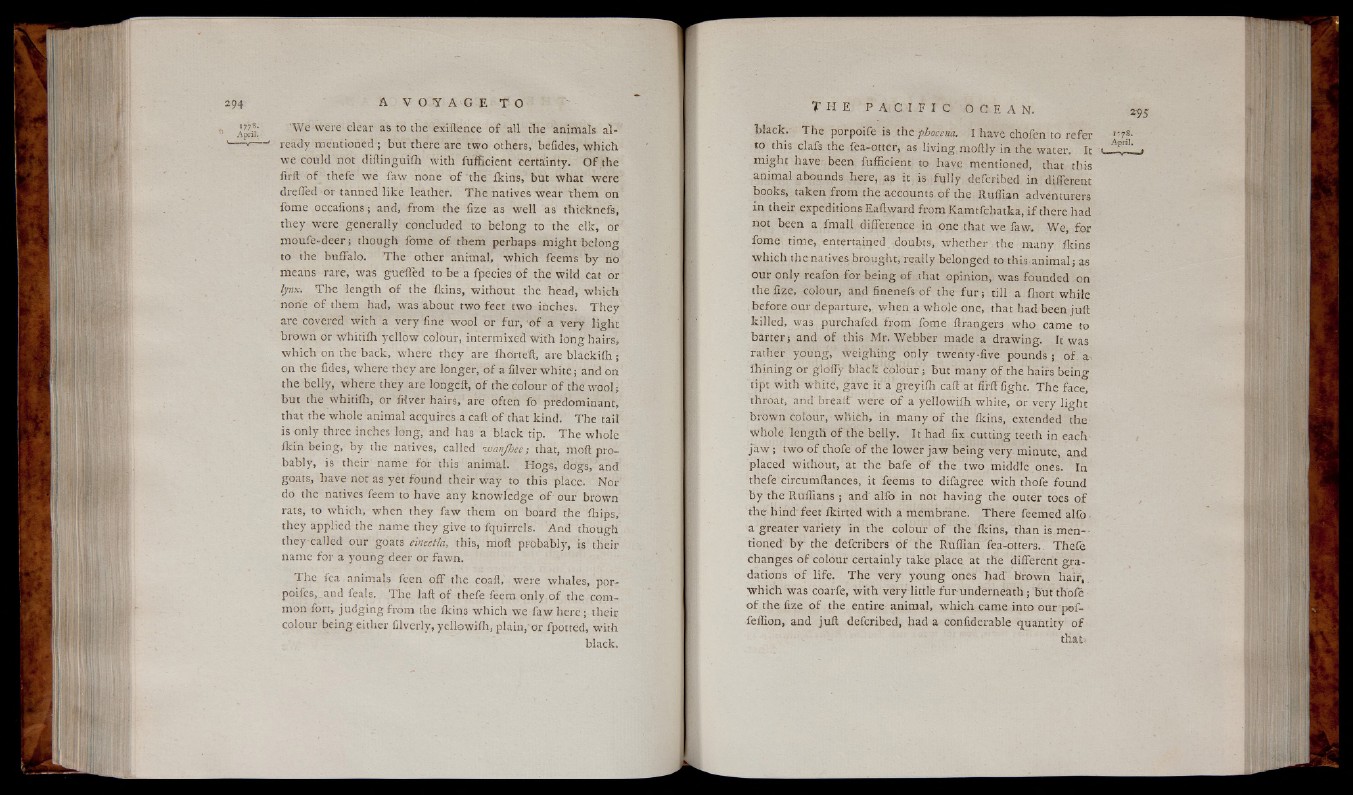
"We were clear as to the exiftence o f all the animals al-
ready mentioned ; but there are two others, befides, w hich
we could not diftinguiih with fufficient certainty. O f the
firft o f thefe we faw none o f the ikins, but What were
drefled or tanned like leather. T h e natives wear them on
fome occafions; and, from the fize as well as thicknefs,
they were generally concluded to belong to the elk , or
moufe-deer; though fome o f them perhaps might belong
to the buffalo. T h e other animal, w hich feems by no
means rare, was gueffed to be a fpecies o f the wild cat or
lynx. T h e length o f the Ikins, without the head, w hich
none o f them had, was about two feet two inches. T h e y
are covered with a very fine wool or fur, o f a ve ry ligh t
brown or w'hitifh yellow colour, intermixed With long hairs,
w h ich on the back, where they are f lion eft, are b la c k ifh ;
on the fides, where they are longer, o f a filver white; and on
the belly, where they are longeft, o f the colour o f the wool;
but the whitifh, or fdver hairs, are often fo predominant,
that the whole animal acquires a caft o f that kind. T he tail
is only three inches long, and has a black tip. The whole
ikfn being, by the natives, called wanjhee; that, moil probably,
is their name for this animal. Hogs, d o g s ,’and
goatSj have not as yet found their w ay to this place. Nor
do the natives feem to have any knowledge o f our brown
rats, to which, when they faw them on board the fhips,
they applied the name they give to fquirrels. And though
they called our goats eirteetla, this, moil probably, is their
name for a youn g deer or fawn.
T h e fea animals feen o ff the coaft, were whales, por-
poifes, and feals. The laft o f thefe feem only o f the common
fort, ju d g in g from the ikins w hich we faw h e re ; their
colour being either fdverly, yellowifli, plain,-or fpotted, with
black.
black. T he porpoife is the phocena. I have chofen to refer
to this clafs the fea-otter, as livin g moftly in the water. It
migh t have been fufficient to have mentioned, that this
animal abounds here, as it is fu lly defcribed in different
books, taken from the accounts o f the Ruffian adventurers
in their expeditions Eaftward from Kamtfchatka, i f there had
not been a fnrall difference in one that we faw. We, for
fome time, entertained doubts, whether the many ikins
w h ich the natives brought, really belonged to this animal; as
our only reafon fo r being o f that opinion, was founded on
the fize, colour, and finenefs o f the f u r ; till a fhort while
before our departure,, when a whole one, that had been ju fl
killed, was purchafed from fome flrangers who came to
barter; and o f this Mr. Webber made a drawing. It was
rather youn g, w e ig h in g only twenty-five p oun d s; of. a,
ihin ing or gloffy black c o lo u r ; but many o f the hairs being
tipt with white, gave it a greyifh caff at firft fight. T he face,
throat, and bread" were o f a yellowifh white, or very ligh t
brown colour, which, in many o f the ikins, extended the
whole length o f the belly. It had fix cutting teeth in each
jaw ; two o f thofe o f the lower jaw being very minute, and
placed without, at the bafe o f the two middle ones. In
thefe circumftances, it feems to difagree with thofe found
by the Ruffians ; and' alfo in not having the outer toes o f
the hind' feet fkirted with a membrane. There feemed a lfo .
a greater variety in the colour o f the ikins, than is mentioned
b y the defcribers o f the Ruffian fea-otters.. Thefe
changes o f colour certainly take place at the different g r a dations
o f life. The very youn g ones had' brown Hair,
w hich was coarfe, with very little fu r underneath; but thofe
o f the fize o f the entire animal, w hich came into our pof-
feffion, and juft defcribed, had a confiderable quantity o f
that;